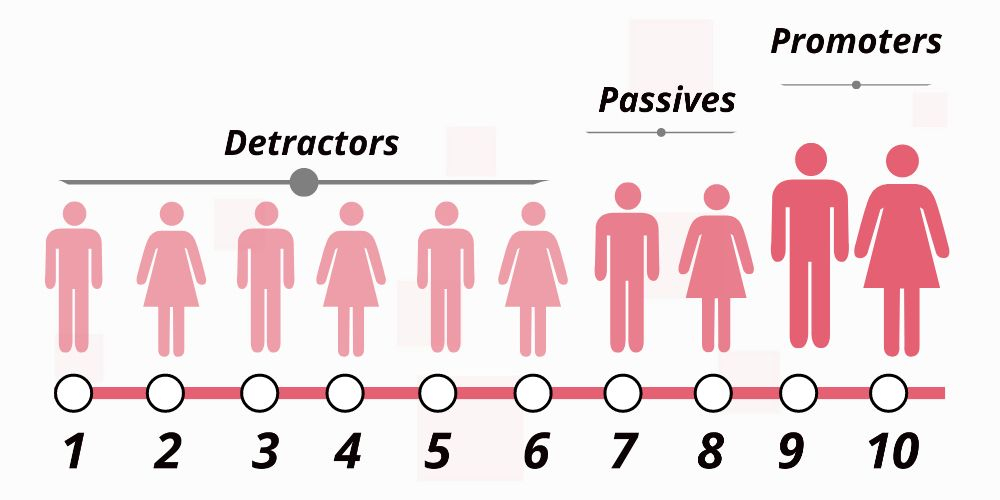Get insights.
Unlock value.
- Free plan, no time limit
- Set up in minutes
- No credit card required
What is Net Promoter Score?
The CEOs of successful business empires have one thing in common, they all understood the power of loyalty in a business. It may be the loyalty of their customers or the employees, but the ignition they can give to your growth is immense. The Net Promoter Score(NPS) is a scientifically calculated metric that determines customer experience and loyalty. The Net Promoter Score gauges how loyal your customers are by conducting a short two-minute survey.
The main strength of NPS lies in its short format that gives a value that in turn helps in growing your customer base and also encourages your existing customer. By establishing people's loyalty towards your brand, your business can kick-in more and more customers from the neutral side to the loyal ones. The Net Promoter Score calculation is straightforward; You need to ask your customer two main questions; the first one is "How likely is it your recommend our product to your friend or colleague?" which is measured against a scale of 1 to 10. The next one will be "What's the most important reason for your score?". It's that simple.
How to calculate NPS?
NPS is a simple scientific calculation that involves three parameters. To start with, you have to ask those two questions to your customer. You can email them directly to your customer; this is the simplest form, or you can give a link to the Survey from your website, but the email one has more response rates than this.
The next thing to be considered is when the companies should send the survey email to the customers, which is another crucial aspect of NPS calculation. You can send the Survey once the purchase is made or every quarter or send it to a percentage of customers in specific time intervals of your choice. But make sure you don't take a long gap between the purchase and the feedback survey because the results may not be accurate. Now your customers have replied, and you get the data you need to calculate NPS. You can check out the NPS calculator on how it works in detail.
Three simple steps to follow:
- Calculate the total number of respondents,
- Calculate the number of respondents who gave you a 9 or 10; they are called "Promoters." They are more likely to exhibit value-creating behaviors, be more satisfied with the product or service, will stay loyal for more extended periods.
- Calculate the number o respondents who gave you a score of 0 to 6; they are called "Detractors." They are less satisfied customers, vulnerable to negative feedback. You may ask whether 6 isn't a good score. Sure, but you must think when someone is giving you a 6, they indeed feel something is wrong with your product or how it reaches them. If someone asks a "Detractor" about the product, they first tell them what the problem is with the product instead of its benefits.
The three parameters you need to calculate NPS are ready, but there is another category of respondents who gave you a 7 or 8. They are called "Passives". Though both are good scores, these people aren't fanatical one way or another, so we leave them out of the final score.

The Net Promoter Score is calculated by subtracting the percentage of Detractors from the percentage of Promoters. So, if 50% of respondents were Promoters and 10% were Detractors, your Net Promoter is a score of 40. It is as simple as that.
Read more here: Net Promoter Score Example
What is the purpose of NPS?
Now you know your companies' NPS value, but do you have these questions in mind, why NPS is calculated, and how it helps a company grow. Here we need to understand the purpose of NPS to know precisely the ground where it is used.
So here are the reasons why is NPS important to a business. The management people in a company are looking for a bigger picture of metric used to know customer loyalty; NPS plays a perfect fit. The NPS value of a company helps understand your industry's competition and how your product/service is doing against the competition.
The NPS value can make it easy for you to identify your company's future efforts' focus area. Let's say you have more number o promoters. You can continually promote your positive reviews to make them more confident about their loyalty. If you have detracters, you must assign someone to take care o their issues and solve them as soon as possible.
NPS is more valuable on a strategic level; it helps track and quantify the score over time. It acts as an internal benchmark.

NPS is proven to be connected with increased business growth. Studies conducted by Harvard Business Review, Satmetrix, and Bain & Company have found a strong correlation between high Net Promoter Scores and revenue. NPS makes it easy to rally all the departments of your company towards one mission.
What is a good Net Promoter Score?
For every Customer experience metric, there is a series of factors that influence, Net Promoter Scale also has such characteristics. A good NPS value varies accordingly for every industry. For example, let's say you are in a food manufacturing industry, and the average NPS of the sector is around 40, and your company's score is 35, then it is a pretty good score. You are doing well in your industry; that's what the value says.
The importance of the Net Promoter Score is that it gives you insights into your customer loyalty spectrum. You cannot provide a definitive NPS score typical to all the business.
How to implement NPS?
Implementing NPS is another important step in the process. If you want to calculate NPS for your business, you have to run an NPS survey to collect customer feedback. There are two main ways of doing a customer feedback survey,
1.Website Survey:
On-page/website pop-up surveys let you capture your customer feedback when still on your website. You can create an NPS survey at the exit point of your purchase or even through the conversation page.
2. Email Survey:
Instead of creating a pop-up page, you can collect the NPS data by emailing the Survey to your customer's email and inviting them to fill in the feedback form after purchase or during a few vital interactions with your business. This works better than the pop-up; customers feel special when your Survey seems to be a way of expressing their original feeling about your product/services.
How to do an NPS follow-up?
While NPS is used as a metric, it plays a more significant role on the other hand also. It creates a relationship with your customer. Though NPS is a number, you should never treat customers as a number. No matter your score, when someone takes time out of their day to give you some feedback, it's an opportunity to engage and deepen your connection with them. Scales like this can provide your numbers that can be used in strategic decisions, but the bond you create with your customer remains a decisive factor towards their loyalty.
Whatever your NPS score or how much a customer rate your product/service, you must appreciate their effort and listen to what they are trying to communicate with you. In case of an issue, your immediate response or action towards rectifying it gives them the feeling of, "Ok, my feedback matters." So the next time you ask them for feedback, they provide a genuine feel about your business. Follow-up is the finish point o this loop.
Conclusion
The history of NPS rows back in 2003, when Fred Reichheld of Bain & Company first presented the metric by way of his paper "One number you need to grow" in Harvard Business Review. It works as one of the best metrics followed by many business conglomerates to find out their customer experience from that time till now. You send a product/service through many processes, starting from production to sales; many people are involved in it. Either it's your employee or your customer, listening to them can give you so many values that no other strategies or business guides can teach you. NPS acts as the one motive or one goal to people at all levels of your organization and drives them to achieve your business's ultimate success.
Get insights.
Unlock value.
- Free plan, no time limit
- Set up in minutes
- No credit card required

